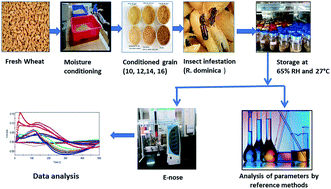Sensor array optimization and determination of Rhyzopertha dominica infestation in wheat using hybrid neuro-fuzzy-assisted electronic nose analysis
Abstract
High grain moisture and temperature provide favorable conditions for stored-grain insect reproduction and survival, which is a major threat in warmer regions. The lesser grain borer Rhyzopertha dominica, a cosmopolitan insect that attacks a wide variety of stored wheat grains, causes serious qualitative and quantitative loss. Wheat grains artificially infested with R. dominica to various degrees and stored up to four different storage periods were evaluated by electronic nose (E-nose) on the basis of quality changes due to chemical inversions. The E-nose consists of 18 metal oxide semiconductor (MOS) sensors and the resistance of all the sensors changes in response to the volatile organic compounds generated from the insect-infested wheat grains. Hybrid adapted neuro-fuzzy interference system models (ANFIS) were used to optimize the sensor array detecting infestation and to predict the number of insects, and uric acid and protein content. The ANFIS models were the best fit, and the sensor responses were fitted closely to predict the number of insects (R = 0.999), uric acid (R = 0.985) and protein content (R = 0.973). The classification of the infested wheat grain samples from the non-infested samples were done effectively by principal component analysis (PCA). The classification performance was weighing up by switching off the nonsignificant sensors. Discrimination of insect infestation by E-nose analysis facilitates industries, warehouses, and exporting agencies to determine the quality of the stored wheat rapidly and systematically throughout the storage period.



 Please wait while we load your content...
Please wait while we load your content...